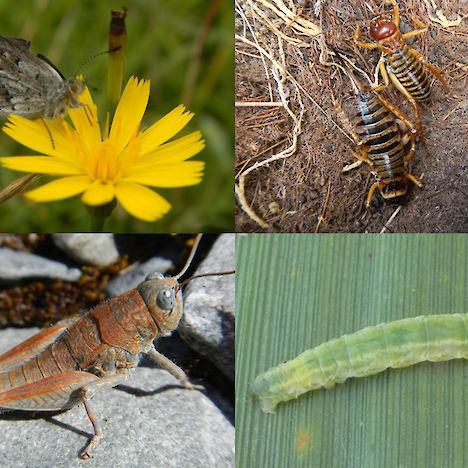Threat category:
Multiple?Regions:
Northland, Auckland, Waikato, Bay of Plenty, Gisborne, Hawkes Bay, Manawatu-Wanganui, Taranaki, Wellington, Nelson-Tasman, Marlborough, Westcoast, Canterbury, Otago, SouthlandDistribution:
Throughout New Zealand
Description
- The terrestrial invertebrates of New Zealand are extremely diverse and often difficult to identify. For identification, managers should either photograph or collect a live specimen, keeping it in a cool ventilated container with foliage, and contact a relevant specialist (e.g. Landcare Research invertebrate specialists).
Interesting Facts
- There are many threatened terrestrial invertebrate species, and many more that are little-known and have not yet been assigned a threat ranking. For example, in the most recent (2012) listing of the threat status of New Zealand’s terrestrial invertebrates, 106 taxa are classified as Nationally Critical, 30 as Nationally Endangered, and 57 as Nationally Vulnerable. A further 1057 are classified as At Risk. 1157 taxa are classified as Data Deficient because there is insufficient information about them.
- Each habitat type is likely to have its own specific invertebrate fauna.
- Some threatened species have adapted to exotic plant species, e.g. Mahoenui giant weta inhabit stands of gorse in the King Country.
Association with Plantation Forests
- Many rare or unclassified invertebrates are found within plantation forests and associated indigenous remnants.
Threats
- Threats will vary by species but could include:
- Loss of indigenous habitat through vegetation clearance or other development.
- Modification of habitat and ecological processes due to the impacts of:
- grazing and browsing animals
- Plant pests
- Fires
- Loss of buffering vegetation.
- Predation by introduced predators such as pigs, rodents, cats, mustelids, hedgehogs, possums, birds, e.g. song thrushes, invertebrates, e.g. Argentine ants, wasps, and garden snails.
Management Options and Methods
- Habitat protection:
- Maintain corridors and remnants of indigenous vegetation. These areas will provide permanent habitat for invertebrates as well as refuges during harvesting for many species that may have entered adjacent plantations.
- Consider permanent protection of natural areas.
- Selecting sites for forestry:
- Undertake surveys by an invertebrate specialist to determine whether populations of at risk species are present and to provide site-specific recommendations.
- Harvesting and post-harvest procedures
- Refer to section on giant land snails.
- Pest control:
- Maintain low possum numbers.
- Seek specialist advice if predation-prone threatened species are known to be present (refer also giant land snails).
- Rodent control may be beneficial in habitat containing sensitive species.
Monitoring Options
- Seek advice from relevant specialists (e.g. Landcare Research specialist invertebrate diagnostics).
Further Information and Support
- Department of Conservation - species information, monitoring and pest control.
- Hitchmough R. et al. (comp.) 2007. New Zealand Threat Classification System lists - 2005. Threatened Species Occasional Publication 23. Department of Conservation, Wellington. 210 pp.
- McGuinness C. 2001. Conservation requirements of New Zealand’s nationally threatened invertebrates. Threatened Species Occasional Publication 20. Department of Conservation, Wellington.
- McGuiness C. 2002. Threatened carabid beetle recovery plan. Department of Conservation, Wellington.
- Pawson S.M., Ecroyd C.E., Seaton R., Shaw W.B. and Brockerhoff E.G. 2010. New Zealand’s exotic plantation forests as habitats for threatened indigenous species. New Zealand Journal of Ecology 34(3): 342-355.
- Sherley G. 1998. Threatened weta recovery plan. Threatened Species Recovery Plan 25. Department of Conservation, Wellington.


